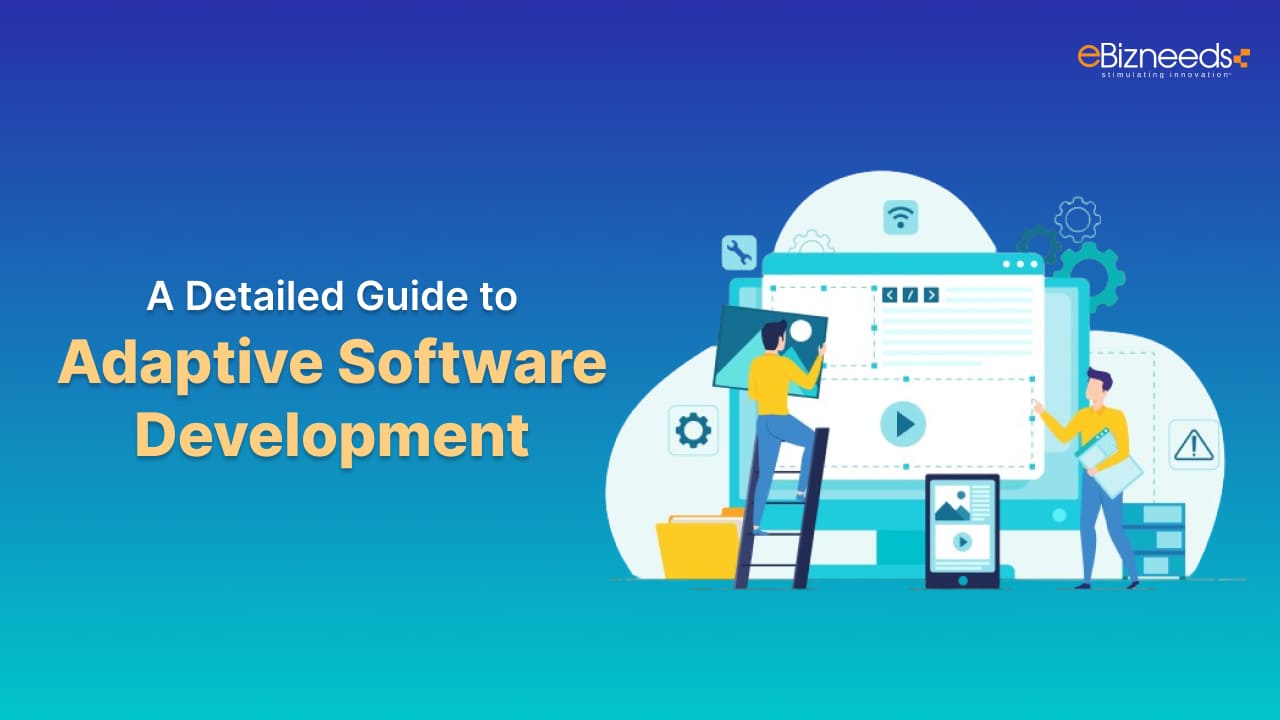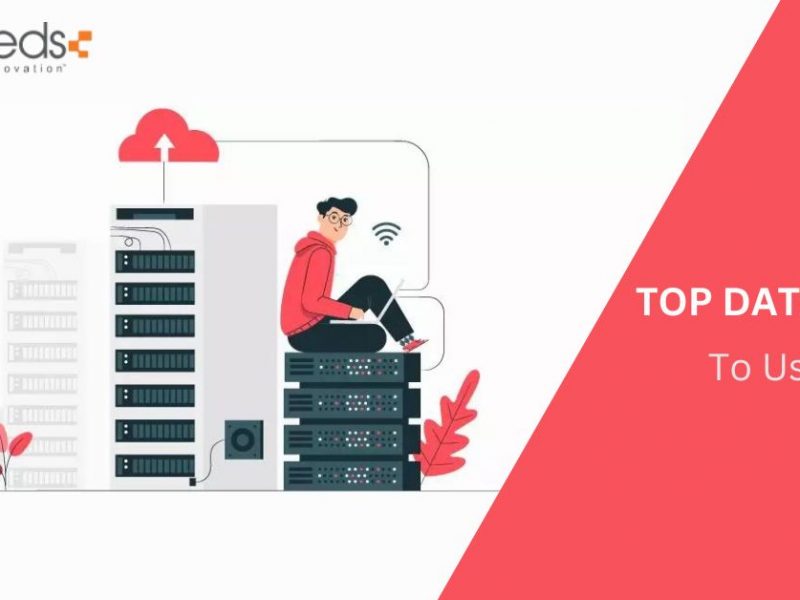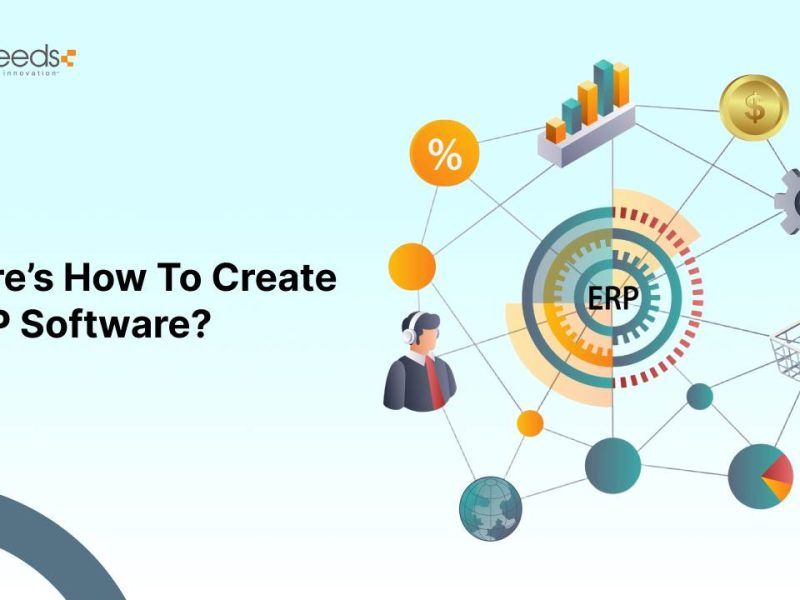In today’s rapidly changing technology world, traditional software development methods face problems in keeping up with the need for flexibility and innovation. To handle all these challenges, adaptive software development has emerged as a new approach. Without a solid software development strategy, projects can fail and become chaotic.
Research shows that 37% of projects fail because of poor management or team problems and another 32% fail due to lack of proper testing methods.
To avoid these issues, companies should use established software methodologies. These methods help deliver high-quality IT projects and handle challenges effectively. The Adaptive Software Development (ASD) methodology is a reliable way to build complex applications while adjusting to changing business needs.
In this blog, we will cover all the important aspects of Adaptive software development, its key features, benefits, the top three phases of the ASD development cycle, and so on. By the end, you will know ASD well and be able to agree if it’s the right fit for your software development project.
Understanding the Meaning of Adaptive Software Development
Adaptive Software Development is a procedure for building software that focuses on being flexible to changing business needs. This helps developers stay agile and make learning a key part of their work. So, what do you understand by Adaptive Software Development? Adaptive development keeps focusing on meeting business requirements and includes the following key elements in the procedure.
- Satisfy Customer: – The final product provides a great user experience because the development team meets the latest business needs and expectations of the project.
- Decentralization Control: – This approach encourages the development team to make accurate decisions themselves rather than following orders from above which often leads to better solutions.
- On Going Testing: – under this process, ongoing testing conducted to find the bugs and fixes it early in the project.
- Manage Risks: – Risk management is an essential part of this process. It means spotting potential risks and taking the right action to reduce the risk.
- Iterative Approach: – The project is divided into small, manageable steps that help to achieve significant processes in each step.
Popular Phases of Adaptive Software Development Life Cycle
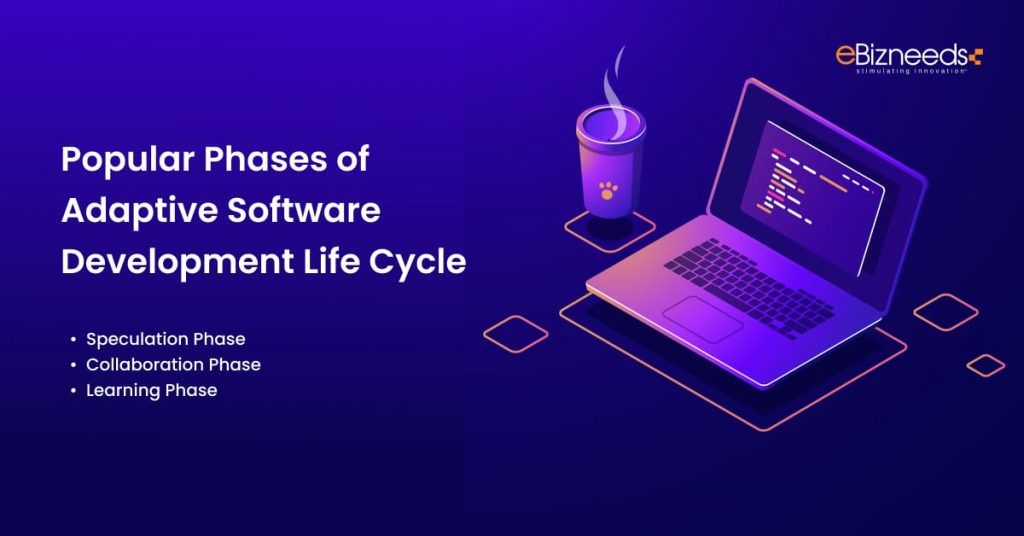


The final product provides a great user experience because its developed to meet the latest needs and expectations of the project.
Speculation Phase
The planning stage in different development methods is similar to the “speculation” phase in Agile Software Development (ASD). While traditional planning relies on certainty, ASD accepts that unpredictability is part of the process and allows room for improvement.
This flexible approach shifts the focus from just doing tasks to achieving results. Planning errors can happen because it’s difficult to predict outcomes. ASD understands that software projects are naturally unpredictable and includes all stakeholders in dealing with this uncertainty.
Collaboration Phase
The development stage is very crucial. Generally it happens when the actual work gets done. Teams with different skills work together to create business applications. They focus on completing reliable tasks while staying flexible to handle any changes. The teams aim to finish predictable tasks but are also ready to adapt to changes from stakeholders, technology, requirements and other factors.
Learning Phase
During the learning phase, teams go through short cycles of creating, building as well as testing. They learn by making small mistakes and fixing them. Over time, this repeated process helps teams build their skills and knowledge.
This stage is similar to the review or retrospective phases in other methods. Teams look at the product from both the customer and technical perspectives. They also check their performance to find ways to improve.
Strength of Adaptive Software Development
Adaptive Software is a great option designed to fix issues found in other software development methods. It’s interesting to explore its strengths.
- Good frameworks can help mobile app developers create complex software quickly.
- it’s simpler and cheaper to fix small issues during these short cycles than to deal with bigger problems later.
- Shorter, smaller iterations make it easier to spot and fix errors early.
- A carefully designed framework that supports trying new things and exploring different ideas.
- Making shorter iterations is also more cost-effective.
- It’s a great choice because it focuses on achieving results.
- Create a collaborative and learning environment to ensure full transparency among all involved.
- Promote accountability while being understanding of mistakes.
- Embrace cultural diversity.
- Test regularly to reduce bugs and other issues.
- Incorporate feedback from end-users throughout the development process.
Key Characteristics of the Adaptive Development Process
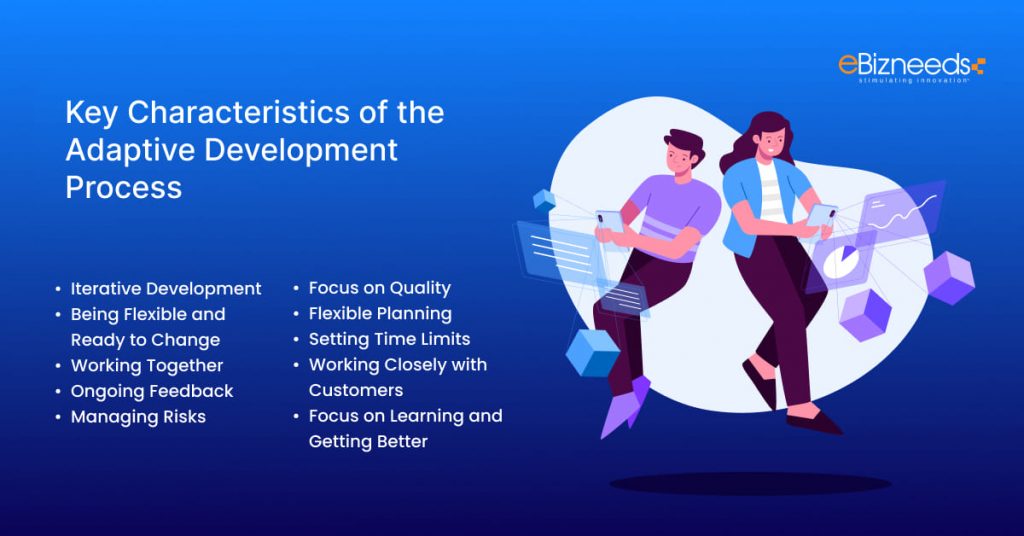


Here we are going to discuss the top features that you should know about adaptive software development. However, its essential to hire a reliable software development company with strong technical skills to build these features. There are popular characteristics of adaptive development.
Iterative Development
Adaptive software development promotes creating software in small steps, where each step involves planning, designing, building, testing and reviewing.
By working in these cycles, software can be delivered within timeframe and continuous feedback and improvements are possible.
Being Flexible and Ready to Change
Adaptive Software Development focuses on being flexible and adapting to demands, new technologies, and evolving business needs. It sees change as a natural part of the development procedure and adjust plan, goals and solutions as needed.
Working Together
In Adaptive Software development, it’s crucial for the development team to work closely with users, clients and stakeholders. This close cooperation helps everyone understand each other better, communicate effectively, align goals and get quick feedback. This is essential for creating software that meet’s everyone’s needs and expectations.
Ongoing Feedback
Adaptive software development focuses on getting regular updates, and feedback through the development procedure. In each step, users and stakeholders offers input to check ideas and enhance features. This helps make sure the project stays in line with altering needs and priorities.
Managing Risks
Adaptive software development uses early risk management to spot, evaluate and address potential issues at initial stage. This enables team reduce the effect of uncertainties on project schedules, cost and quality.
Focus on Quality
Adaptive Software Development risk management to identify, asses and lessen risks in the development process. By quickly dealing with risks, ASD helps reduce their impact on project timelines, cost and quality.
Flexible Planning
ASD focuses on being flexible rather than sticking to rigid long-term plans. Teams adjust their plans based on ongoing feedback, changing needs and new information that helps them stay adaptable and responsive.
Setting Time Limits
In Adaptive Software Development, teams use timeboxing to manage how long tasks or stage take. They set fixed time limits for activities like planning, development and testing. This helps ensure that the work is completed before time period and make it simple to adjust tasks as per priorities.
Working Closely with Customers
ADS focuses on keeping stakeholders and users actively involved throughout the development process. By involving customers frequently, ASD makes sure the software meets needs, is simple to use, and aligns with business goals.
Focus on Learning and Getting Better
In ASD, development teams focus on continuous learning and improvement. After each step, the team review what goes smoothly and what doesn’t from their experience and adopts new methods and practices.



Difference Between Traditional Models and Adaptive Software Development Models
Check out the table below to see more about the adaptive software development model and how it differs from other models.
Development Approach
| Traditional Model | Adaptive Software Development |
| The phases of requirements, design, development, and testing are done one after the other in a set order. | Iterative and incremental development happens in small, repeating cycles. |
Planning
| Traditional Model | Adaptive Software Development |
| A lot of planning is done at the initial stage with clear requirements and design outlined before development begins. | Adaptive planning means that plans change and improve over time based on ongoing feedback and changing needs. |
Flexibility
| Traditional Model | Adaptive Software Development |
| Less Flexible, it will difficult and expensive to bring changes after requirements are set. | Very adaptable, accept changes in requirements, technology and priorities. |
Risk Management
| Traditional Model | Adaptive Software Development |
| Risks are evaluated at the start and managed throughout the project, usually with backup plans in place. | Proactive risk management means spotting risks early and dealing with them in stages. |
Delivery Timeframe
| Traditional Model | Adaptive Software Development |
| Longer delivery cycles mean that software is finished and delivered as a complete product only at the end of the development process. | Frequent updates through shorter development cycle. |
Quality Assurance
| Traditional Model | Adaptive Software Development |
| Testing happens only after each development phase is complete which leaves little room for feedback and changes. | Ongoing testing and integration help find problems early on. |
Team Structure
| Traditional Model | Adaptive Software Development |
| In a hierarchical structure, roles are usually specialized and separate like having distinct roles for developers and testers. | The focus is on having teams with different skills working together and share responsibilities. |
Risk of Scope Creep
| Traditional Model | Adaptive Software Development |
| Less likely to have scope creep because requirements are clearly defined from the start and changes are tightly controlled. | Prevents scope creep by managing changes adaptively and checking progress in stages. |
Overall Project Control
| Traditional Model | Adaptive Software Development |
| Focuses on having control over processes and milestones with little flexibility for changes or adjustments. | Stresses the importance of being flexible and quick to respond with a focus on ongoing improvement. |
Customer Satisfaction
| Traditional Model | Adaptive Software Development |
| You might not know if you’ll be satisfied until the final product is delivered and there are few chances to give feedback early on. | Improved customer satisfaction, ongoing interaction and quick responses. |
What are the Benefits of Adaptive Software Development in Software Engineering?
Like any software development method, Adaptive Software Development (ASD) has its own benefits and drawbacks. ASD can be great for quickly and reliably creating and launching applications but it also has some limitations. Just have a look at the top benefits of ASD:-
- Adaptive Software Development focuses on the needs of the end users.
- This approach helps create software is more user friendly because it pays extra attention to user satisfaction.
- Adaptive Software Development help trams meet the requirements and expectations of everyone involved. This leads to quicker software development and release.
- In the waterfall method, problems might force you to start over that can delay the project’s delivery.
- In ASD, client is the key part of the development procedure. High quality software development services focus on working hard to maintain this teamwork that ensure complete transparency between their teams and clients from start to finish.
Limitations of ASD Process
Adaptive Software Development (ASD) has changed how development team work by providing flexibility and prioritizing software quality over strict procedures used in traditional models. While ASD offers incredible benefits, it also comes with its own challenges.
User Involvement Challenges
ASD requires users to be highly involved during the development process. However, this can be challenging and sometimes causes delays if teams have to wait for feedback and decisions from stakeholders.
Increased Project Price
Including testing at every stage of ASD can increase project costs. While continuous testing helps catch bugs early and ensures quality, it requires extra resources and infrastructure, which can raise expenses.
Scope Creep Risk
The quick cycles and constant feedback in ASD can lead to scope creep, where the project grows beyond what was originally planned. Frequent changes and additions might stretch the project timeline and budget if not carefully managed.
How Much Does It Cost to Build Adaptive Software Development?
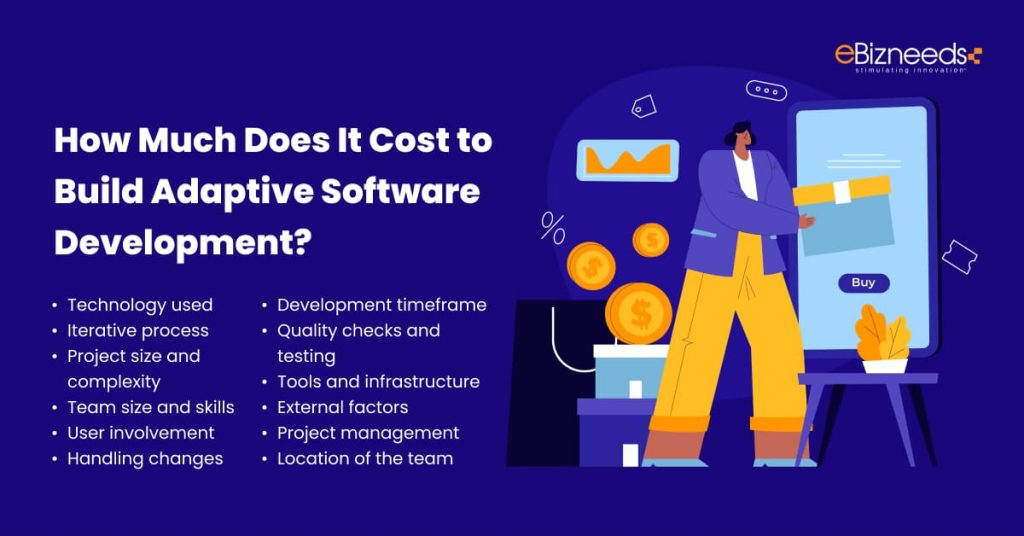


The exact cost of adaptive software development varying depends on the various factors such as project size and complexity, development timeframe, ream size, expertise, user involvement and many more. This method is flexible and adjusts to user needs and changing requirements. Several factors are: –
Technology used
The tools and technologies chosen for development can influence the cost of building SaaS software. Some technologies need licensing fees or special expertise, which can affect the budget.
Iterative process
Iterative cycles are used to build and improve adaptive software. Each cycle adds some cost but lets you make changes based on feedback or new needs.
Project size and complexity
Costs depend on the size and complexity of the project. Larger and more complex projects need more time and resources.
Team size and skills
Costs depend on the size and skill level of the team. Hiring highly skilled and experienced software developers often comes with higher salaries, which can increase overall costs.
User involvement
Adaptive development relies on user feedback and involvement. If you need to do a lot of testing and gather detailed feedback, it might lead to extra costs.
Handling changes
Adaptive development means adjusting to new requirements. Handling these changes, keeping track of them and communicating them can be costly.
Development timeframe
Costs can change based on how long software development takes. If the development time is shorter, you might need to use more resources to meet deadlines, which can raise costs.
Quality checks and testing
To ensure quality and reliability, testing and quality assurance are crucial. However, these activities can increase costs.
Tools and infrastructure
Think about the costs for development tools, version-control systems, hosting and infrastructure. This factor highly impacts the cost of development.
External factors
There might be extra costs for integration or licensing if the project uses third-party components, services or APIs.
Project management
Project management is key to making adaptive software successful. Costs for project management can include salaries for project managers, communication tools and other resources.
Location of the team
Development costs can change based on where the team is located. Differences in labor costs, taxes and other factors can vary by region.
How can eBizneeds Help You with Software Development Using the Adaptive Model?
As a top custom software development company, eBizneeds has been successfully serving clients for over 20 years. Our skilled developers stay updated with market trends and demands. Our expertise ensures that each project’s needs are met. They can help you effectively implement the Adaptive Software Development (ASD) model. Here’s why you should choose us:
- Expertise in Implementing ASD
- Tailored Development Process
- Team Training and Support
- Use of the Latest Tools and Technologies
- Quality Assurance and Thorough Testing
- On-Time Delivery
- 24/7 Availability
eBizneeds collaborates closely with clients to understand their needs and create adaptable solutions. We use agile methods to make quick changes and improvements, delivering software that can scale and grow your business.
Certainly! Here’s the revised version:“We boast a robust team of developers primed to assist you in reaching your objectives. Whether you require tailored software, modernizations for outdated applications, or seamless system integration, we offer Adaptive Software Development (ASD) to empower organizations to remain competitive in the ever-evolving digital landscape.
Conclusion
In summary, agile methodology aims to embrace rather than avoid it. Adaptive software development stands out because it handles the challenges of planning head-on. It’s a great approach for businesses that are willing to invest more upfront, open to new ideas and implementations, and want to see continuous improvements in their products. Don’t wait! Reach out to our teams of experts and begin your project today!
FAQs
ASD deals with changing requirements using these strategies:
Customer Collaboration: Regularly working with customers keeps the development on track with their changing needs.
Iterative Development: Dividing the project into small steps helps regularly review progress.
Adaptive Planning: Plans in ASD are flexible and adjust based on new requirements and feedback.
ASD ensures quality with these methods: –
Continuous Testing: Testing is done throughout development to find issues early.
Refactoring: Regularly updating the code to keep it high-quality and flexible.
Iterative Feedback: Getting regular feedback from stakeholders and customers helps spot and fix quality problems.
ASD can be adjusted for large projects or teams spread across different locations using Scaling Frameworks like SAFe or LeSS and various communication tools.
Adaptive software development is a method that came from Jim Highsmith and Sam Bayer’s work on Rapid Application Development (RAD). It follows the idea that constantly adjusting the procedure to fit the current work is the usual way of doing things.
A key idea in Adaptive Software Development (ASD) is “speculation and adaptation.” Instead of planning every detail of the project from the start, ASD teams make educated guesses about the best approach based on what they know now and adjust their plans as they get more information and feedback.
As well know the adaptive software development is notable for its flexibility and emphasis on ongoing improvement. Meanwhile, other methods have their own strengths such as striking deadlines, focusing on customers, and using integrative cycles.



Naveen Khanna is the CEO of eBizneeds, a company renowned for its bespoke web and mobile app development. By delivering high-end modern solutions all over the globe, Naveen takes pleasure in sharing his rich experiences and views on emerging technological trends. He has worked in many domains, from education, entertainment, banking, manufacturing, healthcare, and real estate, sharing rich experience in delivering innovative solutions.
